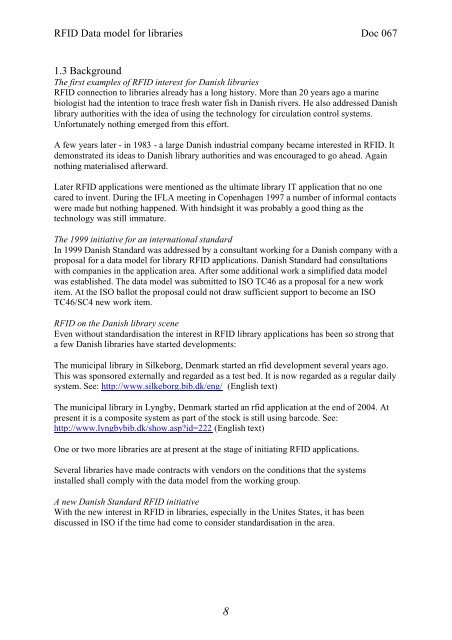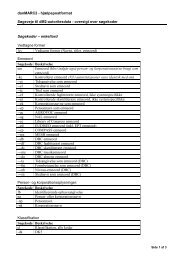RFID Data Model for Libraries - biblstandard
RFID Data Model for Libraries - biblstandard
RFID Data Model for Libraries - biblstandard
You also want an ePaper? Increase the reach of your titles
YUMPU automatically turns print PDFs into web optimized ePapers that Google loves.
<strong>RFID</strong> <strong>Data</strong> model <strong>for</strong> libraries Doc 067<br />
1.3 Background<br />
The first examples of <strong>RFID</strong> interest <strong>for</strong> Danish libraries<br />
<strong>RFID</strong> connection to libraries already has a long history. More than 20 years ago a marine<br />
biologist had the intention to trace fresh water fish in Danish rivers. He also addressed Danish<br />
library authorities with the idea of using the technology <strong>for</strong> circulation control systems.<br />
Un<strong>for</strong>tunately nothing emerged from this ef<strong>for</strong>t.<br />
A few years later - in 1983 - a large Danish industrial company became interested in <strong>RFID</strong>. It<br />
demonstrated its ideas to Danish library authorities and was encouraged to go ahead. Again<br />
nothing materialised afterward.<br />
Later <strong>RFID</strong> applications were mentioned as the ultimate library IT application that no one<br />
cared to invent. During the IFLA meeting in Copenhagen 1997 a number of in<strong>for</strong>mal contacts<br />
were made but nothing happened. With hindsight it was probably a good thing as the<br />
technology was still immature.<br />
The 1999 initiative <strong>for</strong> an international standard<br />
In 1999 Danish Standard was addressed by a consultant working <strong>for</strong> a Danish company with a<br />
proposal <strong>for</strong> a data model <strong>for</strong> library <strong>RFID</strong> applications. Danish Standard had consultations<br />
with companies in the application area. After some additional work a simplified data model<br />
was established. The data model was submitted to ISO TC46 as a proposal <strong>for</strong> a new work<br />
item. At the ISO ballot the proposal could not draw sufficient support to become an ISO<br />
TC46/SC4 new work item.<br />
<strong>RFID</strong> on the Danish library scene<br />
Even without standardisation the interest in <strong>RFID</strong> library applications has been so strong that<br />
a few Danish libraries have started developments:<br />
The municipal library in Silkeborg, Denmark started an rfid development several years ago.<br />
This was sponsored externally and regarded as a test bed. It is now regarded as a regular daily<br />
system. See: http://www.silkeborg.bib.dk/eng/ (English text)<br />
The municipal library in Lyngby, Denmark started an rfid application at the end of 2004. At<br />
present it is a composite system as part of the stock is still using barcode. See:<br />
http://www.lyngbybib.dk/show.asp?id=222 (English text)<br />
One or two more libraries are at present at the stage of initiating <strong>RFID</strong> applications.<br />
Several libraries have made contracts with vendors on the conditions that the systems<br />
installed shall comply with the data model from the working group.<br />
A new Danish Standard <strong>RFID</strong> initiative<br />
With the new interest in <strong>RFID</strong> in libraries, especially in the Unites States, it has been<br />
discussed in ISO if the time had come to consider standardisation in the area.<br />
8




